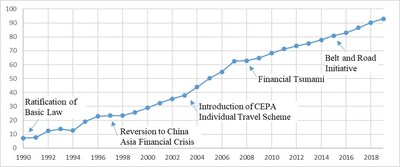Lingnan University announces Hong Kong - Chinese Mainland Economic Integration Index (1990-2019)
PR Newswire
HONG KONG, July 14, 2022
HONG KONG, July 14, 2022 /PRNewswire/ -- In celebrating the 25th Anniversary of Hong Kong's return to China, the Hong Kong Institute of Business Studies (HKIBS) of Lingnan University (LU) in Hong Kong launched the first-ever "Hong Kong – Chinese Mainland Economic Integration Index (1990-2019)". Drawing from the literature on economic integration, the research team used archival data from various sources between 1990 and 2019 to construct a comprehensive index of economic integration. The results indicate that the two economies have become highly integrated and interdependent over time. The findings reveal the positive effect of economic integration on the Hong Kong economy, while highlighting significant challenges to economic development and governance in the SAR.
The Hong Kong – Chinese Mainland Economic Integration Index (1990-2019), developed by the LU research team, includes three dimensions: driving forces (i.e., the development of institutional arrangements that reduce the transaction costs of cross-border economic activities), throughput process (i.e., the trade and investment activities of both sides), and outcome convergence (i.e., the effects of the market homogeneity and market symmetry due to economic integration). To measure the indicators of each dimension, the archival data were retrieved from government sources and international organisations, including the Census and Statistics Department (HKCSD), the National Bureau of Statistics of China, and the World Bank.
The results show that the overall index of economic integration shows a gradual upward trend over the past three decades (Figure 1). Although the index remained at a very low level in the early 1990s (lower than 10 points), the overall index picked up speed since Hong Kong returned to mainland China in 1997 (over 20 points). In 2003, the first Mainland and Hong Kong Closer Economic Partnership Arrangement (CEPA) was signed and the Individual Travel Scheme was introduced. Since then, the level of economic integration continued to grow at an accelerated pace and achieved over 60 points in the 2008 financial tsunami. Starting from 2013, Hong Kong was positioned as a connecting hub in the mainland's Belt and Road Initiative (over 80 points) and the level of economic integration reached a remarkably high level by the end of the study period in 2019 (over 90 points).
As for the three sub-indices, the throughput process played a vital role in enhancing economic integration in the early years. In 2006, the CEPA, as a major driving force, facilitated the closer cooperation of the two economies. Overall, the three sub-indices gradually increased in a linear monotonic trend.
Prof Cui Geng, Professor of the Department of Marketing and International Business of Lingnan University in Hong Kong, said that the economic integration between Hong Kong and mainland China helps eliminate barriers to trade and investment, liberate the factors of production, and encourage efficient resource allocation and production among economic entities. "The level of economic integration between Hong Kong and the mainland grew steadily from 1996 to a remarkably high level in 2019, which indicates an overall positive long-term relationship between the integration index and economic development of Hong Kong. The index is also proportional to the growth of two major economic indicators including GDP and GDP per capita, indicating that economic integration makes an important contribution to Hong Kong's economic growth. In addition, such integration is in tandem with property prices partially due to the money flows from the mainland to Hong Kong as venture capitalists diversify their investments by investing in property, and therefore Hong Kong residential property prices continued to rise. The continuous economic integration also coincides with the increasing economic disparity in the territory, as indicated by the Gini coefficient, one of the highest in the world."
Moreover, Prof Cui said that bilateral price equalisation is the result of continuous economic integration. The negative relationship between the integration index and the coefficient of price variation shows a higher level of price convergence between the two economies.
However, the rising trend of economic integration has not had a significant impact on several social indicators, including the happiness of Hong Kong people, people's satisfaction with the government, and confidence in Hong Kong's future. In fact, the latter two indicators have decreased steadily since the mid-2000s, which may be associated with the increasing income disparity and the soaring prices of private residential properties.
Prof Cui added that these findings provide quantitative information on the economic integration and other socio-economic indicators as well as public sentiment towards the government and society. He said that although Hong Kong-Mainland ties have been the topics of heated debate, whether economic integration can lead to social cohesion and long-term stability remains unclear. He believes that the newly established index will serve as an important reference for policymakers and researchers as they formulate and analyse public policies.
The full report on the "Hong Kong – Chinese Mainland Economic Integration Index (1990-2019)" will be published in the Asia Pacific Business Review.
Photo: https://mma.prnewswire.com/media/1859391/LU_Hong_Kong.jpg
![]() View original content to download multimedia:https://www.prnewswire.com/news-releases/lingnan-university-announces-hong-kong--chinese-mainland-economic-integration-index-1990-2019-301586714.html
View original content to download multimedia:https://www.prnewswire.com/news-releases/lingnan-university-announces-hong-kong--chinese-mainland-economic-integration-index-1990-2019-301586714.html
SOURCE Lingnan University (LU)



